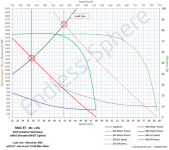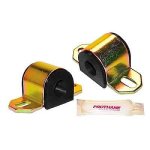Ch00paKabrA
10 kW
I really did do my research, I promise. The only problem is that now I am more confused than ever. I am currently in possession of a MAC 6T that I intended to lace into a motorcycle rim and run it at 72 volts 40a. My goal is to be able to reach 35 to 40 mph for short periods of time and cruise around 25 to 30 mph. After reading a bunch of threads, one in particular about running a MAC 6T at 72v, the general consensus is that it is lunacy.
I have also read threads where it is stated that MACs run great at 60v. So are the additional 12 volts a MAC killer or does it have more to do with the amps.
I have controllers and a charger in my possession and 200 Samsung 18650 25R batteries ordered (not sure when they will show up). I can configure them into any voltage so what is my best option? Can I run this thing at 72 volts? The controllers are one 20a max controller and one 40a max controller.
Any input would be greatly appreciated. If I wasted money on the charger and the controllers, so be it. They weren't very expensive anyway. I just don't want to melt the motor.
Another option is to put the MAC on my beater and run it at 36 or 48 volts. I could then use a different motor on the higher speed bike.
Let me elaborate a little on the uses of the two different bikes. I have one that I frequently pull a bike trailer around that I use for going to the beach (1 mile away) and grocery stores, etc. Just really bumming around. I have a MW Motors 36v 250w rear hub motor that I ran on 72v 10a and didn't have any problems, but it is a torque wind. It only does 16 mph in a 26 in wheel (equivalent) at 36v. After reading all of the warnings though, I switched it back to 36 volts. On 72 volts, it would do over 20 mph. I could just put the MAC on this bike but I am not sure how well it would handle a trailer since it is a speed wind.
The MAC is slated for a Giant DH Comp and I have a family member that lives around 20 miles away. It is flat here with very few hills. The only reason I wanted the higher speed is because there are highway entrances and exits that I must cross and the cars are generally doing around 40 mph or so and it is a bit hectic trying to get by them. I want to be able to burst up to around 40 to get through these danger zones and then slow it back down. Also since she lives 20 miles away, I didn't want to take an hour to get there.
200 25R batteries 20S 10P would have given me 72v (82v actually) 25ah. I figured that would be sufficient and I can recharge while I am there.
I hope that is enough info as to my intended use and expectations.
So here is the deal. I set a budget for the 2 bikes of $5,000.00 I am completely done with the "beater" and that came in at around $1,300.00. I have everything for the Giant DH Comp in my possession except the batteries but they are paid for and I am into it for approximately $2,200.00. Therefore, if I am going to stay in budget, I only have about another $1,500.00 to spend on any changes to the plan. I like the fact that I am under budget and would like to keep it that way if I can. I was going to buy a really nice brand new fork for it If I can come up with a way to meet my needs with what I have spent so far or just needing a new controller and charger.
Thank you in advance for your help.
'Cal
I have also read threads where it is stated that MACs run great at 60v. So are the additional 12 volts a MAC killer or does it have more to do with the amps.
I have controllers and a charger in my possession and 200 Samsung 18650 25R batteries ordered (not sure when they will show up). I can configure them into any voltage so what is my best option? Can I run this thing at 72 volts? The controllers are one 20a max controller and one 40a max controller.
Any input would be greatly appreciated. If I wasted money on the charger and the controllers, so be it. They weren't very expensive anyway. I just don't want to melt the motor.
Another option is to put the MAC on my beater and run it at 36 or 48 volts. I could then use a different motor on the higher speed bike.
Let me elaborate a little on the uses of the two different bikes. I have one that I frequently pull a bike trailer around that I use for going to the beach (1 mile away) and grocery stores, etc. Just really bumming around. I have a MW Motors 36v 250w rear hub motor that I ran on 72v 10a and didn't have any problems, but it is a torque wind. It only does 16 mph in a 26 in wheel (equivalent) at 36v. After reading all of the warnings though, I switched it back to 36 volts. On 72 volts, it would do over 20 mph. I could just put the MAC on this bike but I am not sure how well it would handle a trailer since it is a speed wind.
The MAC is slated for a Giant DH Comp and I have a family member that lives around 20 miles away. It is flat here with very few hills. The only reason I wanted the higher speed is because there are highway entrances and exits that I must cross and the cars are generally doing around 40 mph or so and it is a bit hectic trying to get by them. I want to be able to burst up to around 40 to get through these danger zones and then slow it back down. Also since she lives 20 miles away, I didn't want to take an hour to get there.
200 25R batteries 20S 10P would have given me 72v (82v actually) 25ah. I figured that would be sufficient and I can recharge while I am there.
I hope that is enough info as to my intended use and expectations.
So here is the deal. I set a budget for the 2 bikes of $5,000.00 I am completely done with the "beater" and that came in at around $1,300.00. I have everything for the Giant DH Comp in my possession except the batteries but they are paid for and I am into it for approximately $2,200.00. Therefore, if I am going to stay in budget, I only have about another $1,500.00 to spend on any changes to the plan. I like the fact that I am under budget and would like to keep it that way if I can. I was going to buy a really nice brand new fork for it If I can come up with a way to meet my needs with what I have spent so far or just needing a new controller and charger.
Thank you in advance for your help.
'Cal



